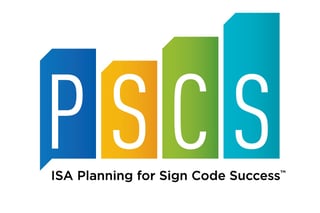It was great to see you at the 2019 National APA Conference in San Francisco!
Presentations
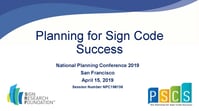 |
"Planning for Sign Code Success" Presentation
|
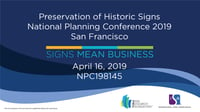 |
“Preserving Historic Signs” Presentation April 16, 2019 |
 |
“25 Preservation Briefs" |
 |
“Hollywood Signage Supplemental Use District" |
Additional Resources
The International Sign Association and the Sign Research Foundation develop research to guide planners and local officials when dealing with sign ordinance issues in your communities.
EMCs | Sign Codes | Best Practices | Reed Decision | Economic Development
Download these free resources by clicking on the report covers below.
EMCs
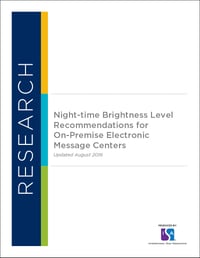 |
Night-time Brightness Level Recommendations for On-Premise Electronic Message Centers (EMCs) Updated in August 2016, this EMC brightness guide is based on peer-reviewed research by Dr. Ian Lewin of Lighting Sciences, Inc. Dr. Lewin is a leading lighting expert with over 30 years experience in the lighting industry. Check out the new version, updated August 2016! |
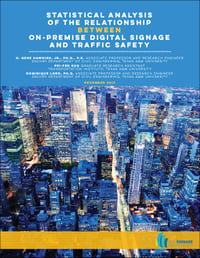 |
Texas A&M University's Transportation Engineering School recently conducted exhaustive research on the traffic safety impact of on-premise electronic message centers (EMCs). This research is the first of its kind, and will provide local decision-makers with the fact-based evidence necessary to enact reasonable and beneficial sign codes. This report also has an executive summary with a statistical analysis and three key takeaways from the original report. |
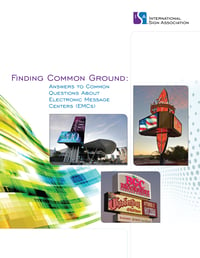 |
This document provides the latest information on how to properly and effectively regulate electronic message centers (EMCs) so that communities and businesses can benefit. |
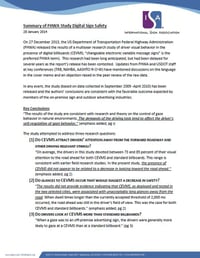 |
Summary of FHWA Study Digital Sign Safety The U.S. Department of Transportation Federal Highway Administration (FHWA) released the results of a multiyear research study of driver visual behavior in the presence of digital billboards. |
|
These videos demonstrate examples of various EMC hold times. Videos created and provided by Yesco Electronics. |
Sign Codes
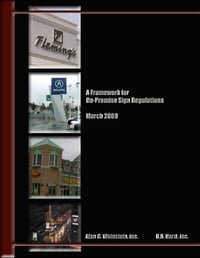 |
Model Sign Code - A Framework for On-Premise Sign Regulations This report outlines the appropriate framework for communities to formulate on-premise sign regulations that respect both community and business interests. This document is most applicable to smaller communities – say those with populations up to several hundred thousand. These communities "typically" possess the variety of character areas that are the basis for the Model Code section. While larger cities may have many similar character areas they may also have a wider variety of unique areas that warrant special considerations that are not addressed in this model. |
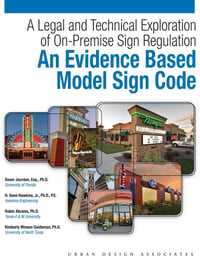 |
Model Sign Code - A Legal and Technical Exploration of On-Premise Sign Regulations Unlike most modern sign codes which attempt to regulate on-premises signs on the basis of police powers, Urban Design Associates has drafted this municipal sign code for the Sign Research Foundation, which is based on the best available transportation planning and engineering research. This evidence-based approach to regulation seeks to ensure that signs, as commercial speech, are afforded some guaranteed constitutional protections. This report begins with a discussion of the legal issues fundamental to the regulation of on-premise commercial signs. Next, the report describes the technical research related to issues of the legibility of on-premise signs. The third section of this report features an evidence-based model sign code, crafted to reflect the identified legal and technical issues. |
|
It doesn’t matter whether it’s a small town or large metropolitan area or something in-between, we all want the same thing in our communities - great quality of life. We might pursue that goal differently, but some basic ideals are universal: a strong and sustainable tax base, prosperous businesses, safe streets and aesthetic appeal. These are goals that city planners, local government officials and business owners strive to reach every day. An effective sign code can be a powerful tool to help achieve these objectives. |
Best Practices
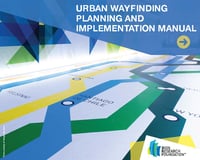 |
The Sign Research Foundation has developed a comprehensive guide to urban wayfinding from planning to implementation. This valuable resource explains system financing, design, regulatory issues, and implementation. |
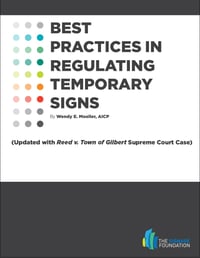 |
Best Practices in Regulating Temporary Signs Compiled by prominent planner Wendy Moeller, AICP, this guide offers communities assistance in understanding different kinds of temporary signs and best practices for regulating each type. |
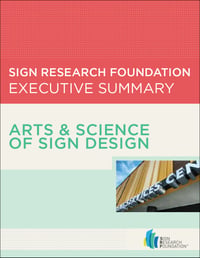 |
To be an effective form of communication, signs must incorporate the science behind artistic design principles. Any regulation must also take these factors into consideration to ensure that signs are both effective and safe. This document includes some of the latest research into applicable scientific principles. |
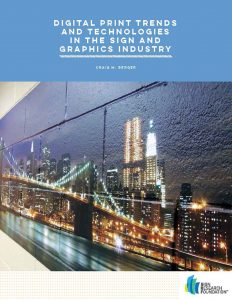 |
Digital Print Trends & Technologies in the Sign and Graphics Industry Digital printing is a key part of nearly every area of the sign and graphics industry. Lack of planning can cost thousands of dollars and hours while successful print management can create new innovations and foster new opportunities. This paper provides an overview of the technologies, methodologies and materials shaping the way designers, fabricators and manufacturers are navigating digital printing processes. |
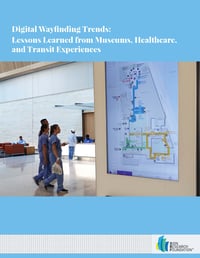 |
Digital Wayfinding Trends – Lessons Learned from Museums, Healthcare, and Transit Experiences Museums, healthcare facilities and transit systems have been particularly forward thinking with fusing traditional and interactive wayfinding, combining apps, indoor location technology, and digital and static signage to guide visitors in and around their facilities. This study explores eight digital wayfinding experiences across the seemingly disparate environments of art museums, hospitals, and public transit to learn what makes for the most successful and seamless blend of digital and physical guidance. Our goal is to assemble lessons in user experience and system design that can be applied to tomorrow’s digital wayfinding projects. |
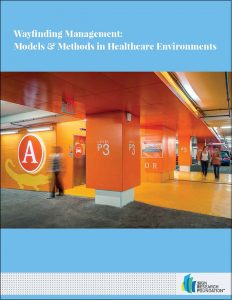 |
Wayfinding Management: Models & Methods in Healthcare Environments |
 |
Typography, Placemaking, and Signs Increased legibility research has led to more effective typefaces—but also more restrictive regulations. This four-part white paper series by Craig Berger includes the history, best practices, ADA code considerations, and case studies for the use of type in our environment and the future of typography. |
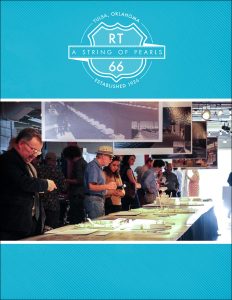 |
String of Pearls: Improving Perception of a Built Environment |
Reed v. Town of Gilbert Decision and Legal Issues
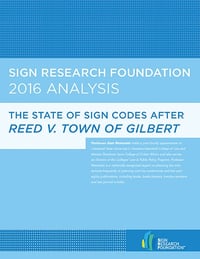 |
The State of Sign Codes After Reed v. Town of Gilbert View insights on the decision from Professor Alan Weinstein, a national noted planning law expert. Prof. Weinstein holds a joint faculty appointment at Cleveland State University’s Cleveland-Marshall College of Law and Maxine Goodman Levin College of Urban Affairs and also serves as Director of the Colleges' Law & Public Policy Program. |
Economic Development
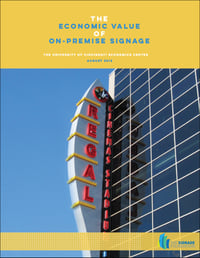 |
The Economic Value of On-Premise Signage The University of Cincinnati's Planning and Business schools recently collaborated to conduct extensive research on the economic value of signs to businesses and communities. This research will provide local sign code officials with the latest information on how signs help businesses communicate with customers, and how communities can benefit from improved economic activity. |
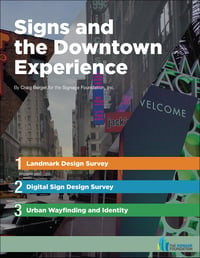 |
Signs and the Downtown Experience The report compares the effectiveness of different approaches to sign design with different strategies and economic trends. The analysis creates a clearer picture of how effective signs can enhance commercial institutions and play an important role in enhancing the community and environment. |
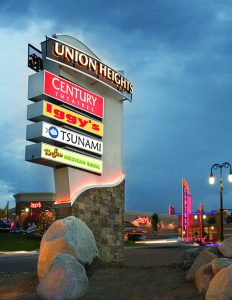 |
Consumer Perceptions of Retail Signage: 100,000 Shoppers Can’t Be Wrong Consumers learn—and assume—all sorts of things about a business based on its sign. This study by Dr. James Kellaris from the Lindner College of Business at the University of Cincinnati offers a wealth of insight into consumer behavior and provides key findings for retailers. |
 |
Retail Signage – Practices to Increase Return on Investment |
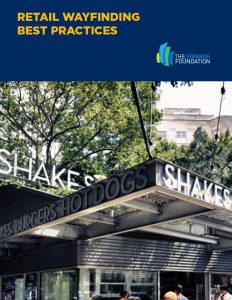 |
Retail Wayfinding Best Practices |
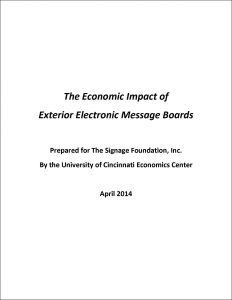 |
The Economic Impact of Exterior Electronic Message Boards |
 |
Illuminated Sign Conspicuity – What Factors Make a Sign Noticeable and Legible? |



